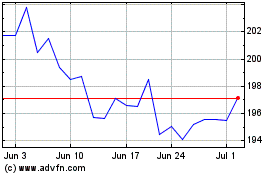WASHINGTON—Federal Reserve officials said an interest-rate
increase was possible "relatively soon" if incoming data continued
to show an improving economy, with some explicitly calling for a
move in December.
Some Fed officials argued that "an increase should occur at the
next meeting," according to minutes of their Nov. 1-2 meeting,
released Wednesday following the usual three-week lag. That
indicated the Fed was leaning toward raising rates at its Dec.
13-14 gathering barring an upset to the economy.
"Most participants expressed a view that it could well become
appropriate to raise the target range for the federal-funds rate
relatively soon," they said.
Still, Fed officials remain split. One camp wanted to hold off
on raising rates until it saw more progress on inflation and
employment, while another was ready to move in early November.
The economic backdrop has changed vastly since that meeting. It
took place before Donald Trump won the U.S. presidential election
on Nov. 8, an outcome that has been felt in financial markets.
Market expectations of a December rate increase have soared
since then due to a stream of healthy economic data and
expectations the president-elect will enact fiscal stimulus once in
office.
Ahead of the minutes' release Wednesday, federal-fund
futures—used by investors and traders to place bets on central-bank
policy—showed that they see a 98.2% likelihood of a rate increase
at the Fed's December policy meeting, according to data from CME
Group.
When Federal Reserve officials met a week before the U.S.
election, they demurred on increasing borrowing costs due to the
relatively limited amount of information available since the
September meeting, preferring to wait for more data on inflation
and employment.
"Members generally agreed that the case for an increase in the
policy rate had continued to strengthen. But a majority of members
judged that the Committee should, for the time being, await some
further evidence of progress toward its objectives," the minutes
said.
While officials generally agreed labor-market conditions had
continued to improve over the intermeeting period, they were more
divided over inflation, according to the minutes.
Although officials regarded higher-than-expected inflation
readings in recent months as a positive development, a few argued
that the uptick could be down to transitory factors, while "a
couple of others" said inflation could move up to the Fed's 2%
target more rapidly than previously expected.
The Fed raised its benchmark federal-funds interest rate from
near zero to a 0.25% to 0.50% range last December, and began the
year expecting to nudge rates up four more times in
quarter-percentage-point increments in 2016. It hasn't moved
because of recurrent worries about growth, hiring and turbulence
overseas.
Policy makers' assessment of the employment situation was
upbeat; they agreed that labor-market conditions had improved
further since the September meeting. However, some argued in favor
of letting the unemployment rate fall below its normal long-run
level to push up inflation.
Taken all together, the minutes largely reinforced market and
analyst expectations of a Fed move in December. An overwhelming
96.5% of economists polled in a recent Wall Street Journal survey,
conducted after the U.S. election, expected the Fed to move
borrowing costs higher at its Dec. 13-14 meeting.
Inflation has run below the Fed's 2% target for more than four
years. However, the minutes noted that inflation had increased in
recent months. The personal-consumption expenditures price index,
the Fed's preferred inflation measure, rose 1.2% in September from
a year earlier—the firmest year-over-year reading since November
2014, but still below target.
Fed Chairwoman Janet Yellen largely echoed the minutes'
depiction of an improving economy when she spoke at Congress's
Joint Economic Committee last week, and told lawmakers that an
increase in interest rates could come "relatively soon."
"At this stage, I do think that the economy is making very good
progress toward our goals," she said. Other Fed officials, like
Dallas Fed President Robert Kaplan, have said in recent days that
the central bank should start removing accommodation.
Economic data have been strong since the last Fed gathering.
Government reports on employment, retail sales and the housing
market have broadly depicted an economy gaining strength. Earlier
Wednesday, the Commerce Department reported that orders for durable
goods posted their biggest jump in a year in October, and U.S.
consumer sentiment surged in November, signaling rising confidence
in the economy as the presidential campaign ended.
The minutes made no direct reference to the election, but "a few
participants reported that uncertainty about prospects for
government policy, shorter investment time horizons for businesses,
or the potential for advances in technology to disrupt existing
business models were likely weighing on capital spending
plans."
Mr. Trump's win sent stocks, bond yields and the U.S. dollar
higher, and shifted the outlook for fiscal, trade and regulatory
policies considerably since the Fed's last policy meeting.
The tax cuts and fiscal spending Mr. Trump has proposed could
send inflation higher, potentially prompting a more aggressive path
of interest-rate increases.
Ms. Yellen said last week that "there's a great deal of
uncertainty" surrounding the Trump administration's plans for
fiscal policy.
"Given my current assessment, we will be watching the decisions
that Congress makes and updating our economic outlook as the policy
landscape becomes clearer and taking into account...the shifts in
the economic outlook for the appropriate stance of policy," she
said.
Write to Harriet Torry at harriet.torry@wsj.com
(END) Dow Jones Newswires
November 23, 2016 14:55 ET (19:55 GMT)
Copyright (c) 2016 Dow Jones & Company, Inc.
CME (NASDAQ:CME)
Historical Stock Chart
From Mar 2024 to Apr 2024

CME (NASDAQ:CME)
Historical Stock Chart
From Apr 2023 to Apr 2024
